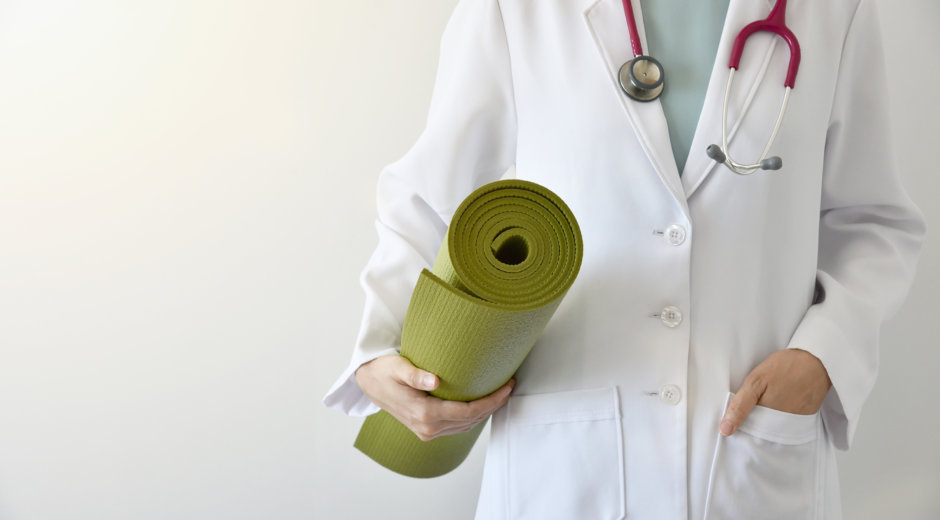Many people start a yoga practice to become more flexible. And yes, flexibility is a very real benefit of yoga, but here we want to scratch the surface and review some deeper science-supported benefits of this age-old practice.
Improved Sleep
As we know, quality of sleep is one of the building blocks of a happy life. Adding a few yoga poses to your bedtime routine can help you fall asleep quicker and stay asleep longer. These restorative poses calm the nervous system and stimulate the parasympathetic nervous system, which helps the body move into a restful state. We recommend Legs up the Wall pose, Happy Baby pose, and Child’s pose. Hold each of these poses for several minutes while slowing your breathing to deep, even inhales and exhales. Even though it might be tempting to do these poses in bed it is best to do them on the floor so that your body is well-supported. Once finished with these poses, climb into bed, close your eyes, and float off with this Yoga Nidra video by Dan Ward.



Improved Self-Esteem
Healthy self-esteem and a good dose of self-confidence are instrumental in being able to make clear decisions without swirling in self-doubt. Mindfulness is defined as “a state of active, open attention to the present. This state is described as observing one’s thoughts and feelings without judging them as good or bad.” Mindfulness practice allows us to be in the present moment, as opposed to the stories we’ve created in the mind. It brings us into a state of focus allowing the noise to fall away. Yoga and meditation are just a couple of ways to bring mindfulness into your life. Standing yoga poses boost self-esteem and self-confidence because these poses can bring a feeling of empowerment. This, in turn, builds a pattern in the brain which can be recalled while off the mat and in everyday life. Experience the benefits of daily yoga and boost your self-esteem and self-confidence with Mountain pose, Tree pose, and Warrior I pose.



Improved Strength
Strength is important for overall health and longevity, and since yoga is a weight-bearing activity it has the ability to build strength and muscle mass. There are many types & styles of yoga but for improved strength, we want to practice active, dynamic styles like Ashtanga, Rocket, and Jivamukti. The quick, repetitive movements mimic high-rep bodyweight exercises. And the long holds of Power yoga build endurance and stamina. Build muscular strength with Plank pose, Boat pose, and Dolphin pose.



Improved Bone Health
Let’s not forget to take care of our bone health. Bone loss is a natural part of aging and some studies reflect a loss of 1% for every year over 40 years of age! So we want to be aware of this early in life and do all we can to maintain and improve our bone health. Where to start? Calcium, vitamin D & K, collagen, and ….. weight-bearing exercises, like yoga. Many studies have shown that yoga is beneficial for bone health. Try Downward Facing Dog pose, Warrior II pose, and Locust pose for improved bone health.



Improved Energy
Fatigue is real. Just think about what 2020 did to our collective energy level. Our at-home yoga practice kept us sane and maintained our energy levels. The three prongs of maintaining high energy levels throughout the day are sleep, nutrition, and movement. Even if a daily practice is out-of-reach, the benefits of weekly yoga are still real. A quick-paced vinyasa yoga flow gets the heart pumping, the blood moving, and brings elevated energy to your system. Deep breathing through pranayama brings increased oxygen to the brain and washes away that afternoon fog. For many people, practicing yoga in the morning shakes out sleepiness and wakes up the brain. Instead of that traditional afternoon coffee break we recommend, 10 to 20-minutes of movement including Chair pose, Camel pose, and Cobra pose followed by this Nadi Shodana pranayama by Annie Carpenter.



Relief from Symptoms of Depression
The benefits of yoga on mental health have been studied with proven results and we now know that meditation and yoga help with depression. Some contributing factors of mild depression are:
- poor sleep which leads to fatigue and brain fog
- poor self-esteem which leads to self-doubt and negative self-talk
- low energy levels which leads to inactivity and stagnation
As we’ve just discussed all of these symptoms can be relieved with a consistent yoga practice, and the deep breathing that goes hand-in-hand with the movement of an asana practice is relaxing and calming. For relief of mild depression try incorporating Easy pose, Bridge pose, and Corpse pose into your daily yoga practice.
Improved Brain Function
The brain is a muscle and muscles need exercise! As cited in this study by Harvard Medical School, “When you do yoga, your brain cells develop new connections, and changes occur in brain structure as well as function, resulting in improved cognitive skills, such as learning and memory. Yoga strengthens parts of the brain that play a key role in memory, attention, awareness, thought, and language. Think of it as weightlifting for the brain.” When you feel your brainpower needs a turbo boost try Standing Half Forward Bend, Plow pose, and Wide Angle Seated Forward Bend.



These are just a few of the many science-based benefits of yoga. We hope you take some time today and every day to explore this simple practice that provides so many positive effects on you and those around you.


Write Your Comment
Leave a comment